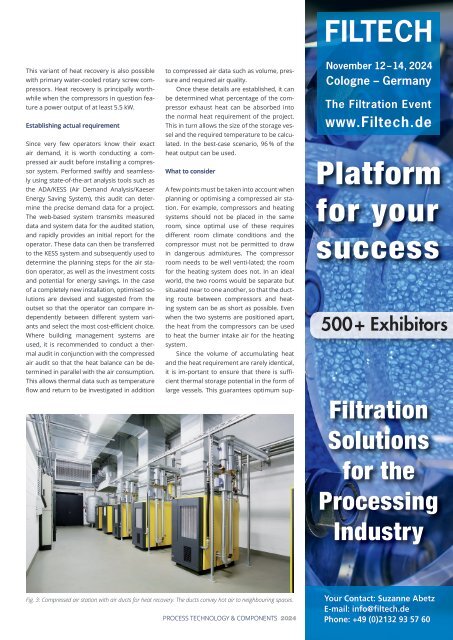PuK - Process Technology & Components 2024
A technical trade magazine with a history of more than 60 years.
A technical trade magazine with a history of more than 60 years.
Create successful ePaper yourself
Turn your PDF publications into a flip-book with our unique Google optimized e-Paper software.
FILTECH<br />
This variant of heat recovery is also possible<br />
with primary water-cooled rotary screw compressors.<br />
Heat recovery is principally worthwhile<br />
when the compressors in question feature<br />
a power output of at least 5.5 kW.<br />
Establishing actual requirement<br />
Since very few operators know their exact<br />
air demand, it is worth conducting a compressed<br />
air audit before installing a compressor<br />
system. Performed swiftly and seamlessly<br />
using state-of-the-art analysis tools such as<br />
the ADA/KESS (Air Demand Ana lysis/Kaeser<br />
Energy Saving System), this audit can determine<br />
the precise demand data for a project.<br />
The web-based system transmits measured<br />
data and system data for the audited station,<br />
and rapidly provides an initial report for the<br />
operator. These data can then be transferred<br />
to the KESS system and subsequently used to<br />
determine the planning steps for the air station<br />
operator, as well as the investment costs<br />
and potential for energy savings. In the case<br />
of a completely new installation, optimised solutions<br />
are devised and suggested from the<br />
outset so that the operator can compare independently<br />
between different system variants<br />
and select the most cost-efficient choice.<br />
Where building management systems are<br />
used, it is recommended to conduct a thermal<br />
audit in conjunction with the compressed<br />
air audit so that the heat balance can be determined<br />
in parallel with the air consumption.<br />
This allows thermal data such as temperature<br />
flow and return to be investigated in addition<br />
to compressed air data such as volume, pressure<br />
and required air quality.<br />
Once these details are established, it can<br />
be determined what percentage of the compressor<br />
exhaust heat can be absorbed into<br />
the normal heat requirement of the project.<br />
This in turn allows the size of the storage vessel<br />
and the required temperature to be calculated.<br />
In the best-case scenario, 96 % of the<br />
heat output can be used.<br />
What to consider<br />
A few points must be taken into account when<br />
planning or optimising a compressed air station.<br />
For example, compressors and heating<br />
systems should not be placed in the same<br />
room, since optimal use of these requires<br />
different room climate conditions and the<br />
compressor must not be permitted to draw<br />
in dangerous admixtures. The compressor<br />
room needs to be well venti-lated; the room<br />
for the heating system does not. In an ideal<br />
world, the two rooms would be separate but<br />
situated near to one another, so that the ducting<br />
route between compressors and heating<br />
system can be as short as possible. Even<br />
when the two systems are positioned apart,<br />
the heat from the compressors can be used<br />
to heat the burner intake air for the heating<br />
system.<br />
Since the volume of accumulating heat<br />
and the heat requirement are rarely identical,<br />
it is im-portant to ensure that there is sufficient<br />
thermal storage potential in the form of<br />
large vessels. This guarantees optimum sup-<br />
November 12 – 14, <strong>2024</strong><br />
Cologne – Germany<br />
The Filtration Event<br />
www.Filtech.de<br />
Platform<br />
for your<br />
success<br />
500+ Exhibitors<br />
Filtration<br />
Solutions<br />
for the<br />
<strong>Process</strong>ing<br />
Industry<br />
Fig. 3: Compressed air station with air ducts for heat recovery. The ducts convey hot air to neighbouring spaces.<br />
PROCESS TECHNOLOGY & COMPONENTS <strong>2024</strong><br />
Your Contact: Suzanne Abetz<br />
E-mail: info@filtech.de<br />
Phone: +49 (0)2132 93 57 60

















